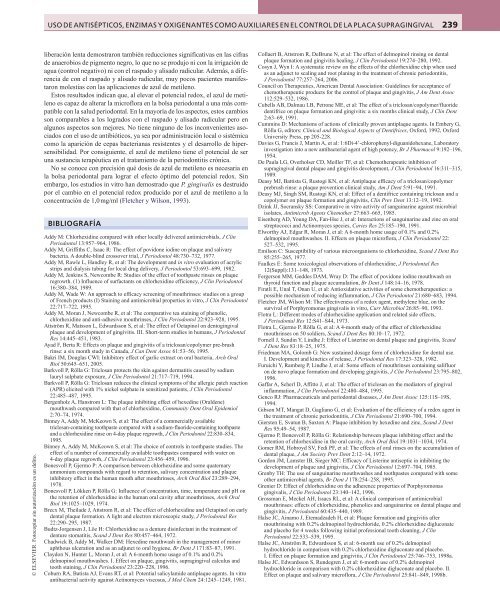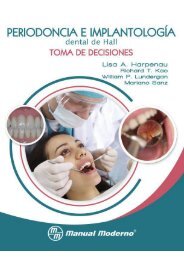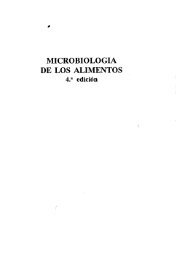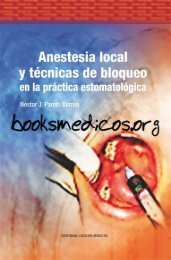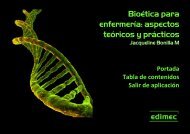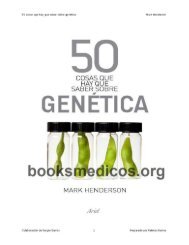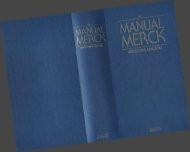Periodoncia.Eley.6a.Ed
You also want an ePaper? Increase the reach of your titles
YUMPU automatically turns print PDFs into web optimized ePapers that Google loves.
Uso de antisépticos, enzimas y oxigenantes como auxiliares en el control de la placa supragingival 239<br />
© ELSEVIER. Fotocopiar sin autorización es un delito.<br />
liberación lenta demostraron también reducciones significativas en las cifras<br />
de anaerobios de pigmento negro, lo que no se produjo ni con la irrigación de<br />
agua (control negativo) ni con el raspado y alisado radicular. Además, a diferencia<br />
de con el raspado y alisado radicular, muy pocos pacientes manifestaron<br />
molestias con las aplicaciones de azul de metileno.<br />
Estos resultados indican que, al elevar el potencial redox, el azul de metileno<br />
es capaz de alterar la microflora en la bolsa periodontal a una más compatible<br />
con la salud periodontal. En la mayoría de los aspectos, estos cambios<br />
son comparables a los logrados con el raspado y alisado radicular pero en<br />
algunos aspectos son mejores. No tiene ninguno de los inconvenientes asociados<br />
con el uso de antibióticos, ya sea por administración local o sistémica<br />
como la aparición de cepas bacterianas resistentes y el desarrollo de hipersensibilidad.<br />
Por consiguiente, el azul de metileno tiene el potencial de ser<br />
una sustancia terapéutica en el tratamiento de la periodontitis crónica.<br />
No se conoce con precisión qué dosis de azul de metileno es necesaria en<br />
la bolsa periodontal para lograr el efecto óptimo del potencial redox. Sin<br />
embargo, los estudios in vitro han demostrado que P. gingivalis es destruido<br />
por el cambio en el potencial redox producido por el azul de metileno a la<br />
concentración de 1,0 mg/ml (Fletcher y Wilson, 1993).<br />
Bibliografía<br />
Addy M: Chlorhexidine compared with other locally delivered antimicrobials, J Clin<br />
Periodontol 13:957–964, 1986.<br />
Addy M, Griffiths C, Isaac R: The effect of povidone iodine on plaque and salivary<br />
bacteria. A double-blind crossover trial, J Periodontol 48:730–732, 1977.<br />
Addy M, Rawle L, Handley R, et al: The development and in vitro evaluation of acrylic<br />
strips and dialysis tubing for local drug delivery, J Periodontol 53:693–699, 1982.<br />
Addy M, Jenkins S, Newcombe R: Studies of the effect of toothpaste rinses on plaque<br />
regrowth. (1) Influence of surfactants on chlorhexidine efficiency, J Clin Periodontol<br />
16:380–384, 1989.<br />
Addy M, Wade W: An approach to efficacy screening of mouthrinses: studies on a group<br />
of French products (I) Staining and antimicrobial properties in vitro, J Clin Periodontol<br />
22:717–722, 1995.<br />
Addy M, Moran J, Newcombe R, et al: The comparative tea staining of phenolic,<br />
chlorhexidine and anti-adhesive mouthrinses, J Clin Periodontol 22:923–928, 1995.<br />
Attström R, Matsson L, <strong>Ed</strong>wardsson S, et al: The effect of Octapinol on dentogingival<br />
plaque and development of gingivitis. III. Short-term studies in humans, J Periodontal<br />
Res 14:445–451, 1983.<br />
Ayad F, Berta R: Effects on plaque and gingivitis of a triclosan/copolymer pre-brush<br />
rinse: a six month study in Canada, J Can Dent Assoc 61:53–56, 1995.<br />
Bakri IM, Douglas CWI: Inhibitory effect of garlic extract on oral bacteria, Arch Oral<br />
Biol 50:645–651, 2005.<br />
Barkvoll P, Rölla G: Triclosan protects the skin against dermatitis caused by sodium<br />
lauryl sulphate exposure, J Clin Periodontol 21:717–719, 1994.<br />
Barkvoll P, Rölla G: Triclosan reduces the clinical symptoms of the allergic patch reaction<br />
(APR) elicited with 1% nickel sulphate in sensitized patients, J Clin Periodontol<br />
22:485–487, 1995.<br />
Bergenholz A, Hanstrom L: The plaque inhibiting effect of hexedine (Oraldene)<br />
mouthwash compared with that of chlorhexidine, Community Dent Oral Epidemiol<br />
2:70–74, 1974.<br />
Binney A, Addy M, McKeown S, et al: The effect of a commercially available<br />
triclosan-containing toothpaste compared with a sodium-fluoride-containing toothpaste<br />
and a chlorhexidine rinse on 4-day plaque regrowth, J Clin Periodontol 22:830–834,<br />
1995.<br />
Binney A, Addy M, McKeown S, et al: The choice of controls in toothpaste studies. The<br />
effect of a number of commercially available toothpastes compared with water on<br />
4-day plaque regrowth, J Clin Periodontol 23:456–459, 1996.<br />
Bonesvoll P, Gjermo P: A comparison between chlorhexidine and some quaternary<br />
ammonium compounds with regard to retention, salivary concentration and plaque<br />
inhibitory effect in the human mouth after mouthrinses, Arch Oral Biol 23:289–294,<br />
1978.<br />
Bonesvoll P, Lökken P, Rölla G: Influence of concentration, time, temperature and pH on<br />
the retention of chlorhexidine in the human oral cavity after mouthrinses, Arch Oral<br />
Biol 19:1025–1029, 1974.<br />
Brecx M, Theilade J, Attstrom R, et al: The effect of chlorhexidine and Octapinol on early<br />
dental plaque formation. A light and electron microscopic study, J Periodontal Res<br />
22:290–295, 1987.<br />
Budtz-Jorgensen J, Löe H: Chlorhexidine as a denture disinfectant in the treatment of<br />
denture stomatitis, Scand J Dent Res 80:457–464, 1972.<br />
Chadwick B, Addy M, Walker DM: Hexedine mouthwash in the management of minor<br />
aphthous ulceration and as an adjunct to oral hygiene, Br Dent J 171:83–87, 1991.<br />
Claydon N, Hunter L, Moran J, et al: A 6-month home usage of 0.1% and 0.2%<br />
delmopinol mouthwashes. I. Effect on plaque, gingivitis, supragingival calculus and<br />
tooth staining, J Clin Periodontol 23:220–228, 1996.<br />
Coburn RA, Batista AJ, Evans RT, et al: Potential salicylamide antiplaque agents. In vitro<br />
antibacterial activity against Actinomyces viscosus, J Med Chem 24:1245–1249, 1981.<br />
Collaert B, Attstrom R, DeBrune N, et al: The effect of delmopinol rinsing on dental<br />
plaque formation and gingivitis healing, J Clin Periodontol 19:274–280, 1992.<br />
Cosyn J, Wyn I: A systematic review on the effects of the chlorhexidine chip when used<br />
as an adjunct to scaling and root planing in the treatment of chronic periodontitis,<br />
J Periodontol 77:257–264, 2006.<br />
Council on Therapeutics, American Dental Association: Guidelines for acceptance of<br />
chemotherapeutic products for the control of plaque and gingivitis, J Am Dent Assoc<br />
112:529–532, 1986.<br />
Cubells AB, Dalmau LB, Petrone ME, et al: The effect of a triclosan/copolymer/fluoride<br />
dentifrice on plaque formation and gingivitis: a six months clinical study, J Clin Dent<br />
2:63–69, 1991.<br />
Cummins D: Mechanisms of actions of clinically proven antiplaque agents. In Embery G,<br />
Rölla G, editors: Clinical and Biological Aspects of Dentifrices, Oxford, 1992, Oxford<br />
University Press, pp 205-228.<br />
Davies G, Francis J, Martin A, et al: 1:6Di-49-chlorophenyl-diguanidohexane, Laboratory<br />
investigation into a new antibacterial agent of high potency, Br J Pharmacol 9:192–196,<br />
1954.<br />
De Paula LG, Overholser CD, Meiller TF, et al: Chemotherapeutic inhibition of<br />
supragingival dental plaque and gingivitis development, J Clin Periodontol 16:311–315,<br />
1989.<br />
Deasy MJ, Battista G, Rustogi KN, et al: Antiplaque efficacy of a triclosan/copolymer<br />
prebrush rinse: a plaque prevention clinical study, Am J Dent 5:91–94, 1991.<br />
Deasy MJ, Singh SM, Rustogi KN, et al: Effect of a dentifrice containing triclosan and a<br />
copolymer on plaque formation and gingivitis, Clin Prev Dent 13:12–19, 1992.<br />
Dzink JJ, Socransky SS: Comparative in vitro activity of sanguinarine against microbial<br />
isolates, Antimicrob Agents Chemother 27:663–665, 1985.<br />
Eisenberg AD, Young DA, Fan-Hse J, et al: Interactions of sanguinarine and zinc on oral<br />
streptococci and Actinomyces species, Caries Res 25:185–190, 1991.<br />
Elworthy AJ, <strong>Ed</strong>gar R, Moran J, et al: A 6-month home usage of 0.1% and 0.2%<br />
delmopinol mouthwashes. II. Effects on plaque microflora, J Clin Periodontol 22:<br />
527–532, 1995.<br />
Emilson C: Susceptibility of various microorganisms to chlorhexidine, Scand J Dent Res<br />
85:255–265, 1977.<br />
Faulkes E: Some toxicological observations of chlorhexidine, J Periodontal Res<br />
12(Suppl):131–148, 1973.<br />
Fergerson MM, Geddes DAM, Wray D: The effect of povidone iodine mouthwash on<br />
thyroid function and plaque accumulation, Br Dent J 148:14–16, 1978.<br />
Firatli E, Unal T, Onan U, et al: Antioxidative activities of some chemotherapeutics: a<br />
possible mechanism of reducing inflammation, J Clin Periodontol 21:680–683, 1994.<br />
Fletcher JM, Wilson M: The effectiveness of a redox agent, methylene blue, on the<br />
survival of Porphyromonas gingivalis in vitro, Curr Microbiol 26:85–90, 1993.<br />
Flotra L: Different modes of chlorhexidine application and related side effects,<br />
J Periodontal Res 12:S41–S44, 1973.<br />
Flotra L, Gjermo P, Rölla G, et al: A 4-month study of the effect of chlorhexidine<br />
mouthrinses on 50 soldiers, Scand J Dent Res 80:10–17, 1972.<br />
Fornell J, Sundin Y, Lindhe J: Effect of Listerine on dental plaque and gingivitis, Scand<br />
J Dent Res 83:18–25, 1975.<br />
Friedman MA, Golomb G: New sustained dosage form of chlorhexidine for dental use.<br />
I. Development and kinetics of release, J Periodontal Res 17:323–328, 1982.<br />
Furuichi Y, Ramberg P, Lindhe J, et al: Some effects of mouthrinses containing salifluor<br />
on de novo plaque formation and developing gingivitis, J Clin Periodontol 23:795–802,<br />
1996.<br />
Gaffar A, Scherl D, Affitto J, et al: The effect of triclosan on the mediators of gingival<br />
inflammation, J Clin Periodontol 22:480–484, 1995.<br />
Genco RJ: Pharmaceuticals and periodontal diseases, J Am Dent Assoc 125:11S–19S,<br />
1994.<br />
Gibson MT, Mangat D, Gagliano G, et al: Evaluation of the efficiency of a redox agent in<br />
the treatment of chronic periodontitis, J Clin Periodontol 21:690–700, 1994.<br />
Giersten E, Svatun B, Saxton A: Plaque inhibition by hexedine and zinc, Scand J Dent<br />
Res 95:49–54, 1987.<br />
Gjermo P, Bonesvoll P, Rölla G: Relationship between plaque inhibiting effect and the<br />
retention of chlorhexidine in the oral cavity, Arch Oral Biol 19:1031–1034, 1974.<br />
Gomer RM, Hobroyd SV, Fedi PF, et al: The effects of oral rinses on the accumulation of<br />
dental plaque, J Am Society Prev Dent 2:12–14, 1972.<br />
Gordon JM, Lamster IB, Sieger MC: Efficacy of Listerine antiseptic in inhibiting the<br />
development of plaque and gingivitis, J Clin Periodontol 12:697–704, 1985.<br />
Grenby TH: The use of sanguinarine mouthwashes and toothpastes compared with some<br />
other antimicrobial agents, Br Dent J 178:254–258, 1995.<br />
Grenier D: Effect of chlorhexidine on the adherence properties of Porphyromonas<br />
gingivalis, J Clin Periodontol 23:140–142, 1996.<br />
Grossman E, Meckel AH, Issacs RL, et al: A clinical comparison of antimicrobial<br />
mouthrinses: effects of chlorhexidine, phenolics and sanguinarine on dental plaque and<br />
gingivitis, J Periodontol 60:435–440, 1989.<br />
Halse JC, Ainamo J, Etemadzadeh H, et al: Plaque formation and gingivitis after<br />
mouthrinsing with 0.2% delmopinol hydrochloride, 0.2% chlorhexidine digluconate<br />
and placebo for 4 weeks following initial professional tooth cleaning, J Clin<br />
Periodontol 22:533–539, 1995.<br />
Halse JC, Attström R, <strong>Ed</strong>wardsson S, et al: 6-month use of 0.2% delmopinol<br />
hydrochloride in comparison with 0.2% chlorhexidine digluconate and placebo.<br />
I. Effect on plaque formation and gingivitis, J Clin Periodontol 25:746–753, 1998a.<br />
Halse JC, <strong>Ed</strong>wardsson S, Rundegren J, et al: 6-month use of 0.2% delmopinol<br />
hydrochloride in comparison with 0.2% chlorhexidine digluconate and placebo. II.<br />
Effect on plaque and salivary microflora, J Clin Periodontol 25:841–849, 1998b.


